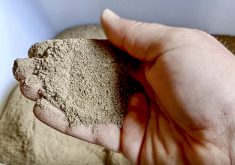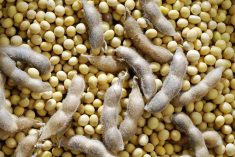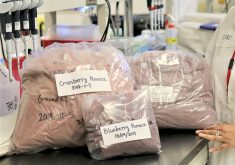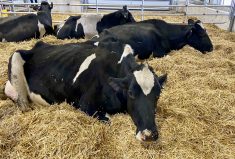Glacier FarmMedia – Multiple disease-causing viruses have been proven to survive for extended periods in imported plant-based animal feed, but what temperature can kill them?
Researchers released data on the issue earlier this year. They want to develop science-based procedures to safely import essential ingredients from countries afflicted with animal viruses.
“We wanted to determine at 30 days of storage, what temperature do you need to hold feed at to kill viruses,” said Dr. Scott Dee, director of applied research with Pipestone Veterinary Services in Minnesota, which specializes in swine research, health and veterinary services.
Read Also

Dissolving eartags could make pig traceability easier
A dissolving eartag for market hogs, called Clean Trace could reduce processing challenges and enable more individual management of pigs.
Why it matters: Plant-based feed ingredients such as soy have been determined to harbour viruses such as PED and ASF for weeks at low temperatures.
There is abundant evidence that feed is a vehicle for the transport and transmission of multiple viral pathogens affecting livestock.
About eight years ago, Dee’s research confirmed porcine epidemic diarrhea virus (PED), porcine reproductive and respiratory syndrome virus (PRRS) and Seneca Valley A (SVA) virus — all dangerous to pigs — could survive in transported feed.
Much has been learned since then about managing feed risk, Dee told participants at the recent Animal Nutrition Conference of Canada event in Saskatoon.
“We never really experienced feed as a vehicle for virus transmission. Sure, for salmonella bacteria and aflatoxin (fungi), but nothing about viruses,” he said to the gathering of researchers and nutritionists.
Dee said that in 2014, several large biosecure swine operations from different American states that got feed from different mills had outbreaks of PED a few days after the feed was delivered and consumed.
The only connection was that the farms reported a resupply of feed at the same time.
It was discovered that viruses could move in feed ingredients. In this case, the feed was imported from areas of high risk, including China and Eastern Europe.
“If there’s a lot of virus in the environment, perhaps this is how the feed could be contaminated. I feel this is definitely the case when it comes to African swine fever (ASF) viruses reported in China in September of 2018,” said Dee.
“This virus has been detected in the commercial feed system in China many times over, as has PED virus. So, I think this is how the feed gets contaminated. It just runs into the virus in the environment.”
Researchers later proved that independent of temperature, viruses in different kinds of soy products can survive the month-long ocean crossing to North American ports, where they are then trucked to mills and delivered to swine operations.
“All the soy ingredients are extremely protective and viruses really love to live in soy for some strange reason,” Dee said. “This was a big deal. This is what the CFIA (Canadian Food Inspection Agency) and the CPC (Canadian Pork Council) used to realize the risk of ASF surviving and coming into Canada. So, they built a national program on this as well as other scientific publications.”
Canada has a national program to manage feed risk using designated control zones, but the United States is a producer-led system where companies set up and manage their own warehouses for feed storage, said Dee.
U.S. researchers have completed a series of successful experiments using commercial additives to help mitigate viruses in feed.
Even in the face of infection, pigs showed improved health and performance with mitigated feed versus non-mitigated feed.
The additives reduce the virus but they don’t sterilize the virus in the feed, Dee explained. A standard 30 days of storage is recommended but a temperature standard was previously unknown.
Researchers wanted to know the temperature that would inactivate viruses in feed over a 30-day storage period and thought higher temperatures would be key.
They inoculated one-tonne totes of conventional soybean meal with PRRS 144 1C variant and SVA prior to storage for 30 days at 24 C, 15 C and 10 C, and then fed it to pigs.
The viruses were inactive in the soy stored at 24 C.
In contrast, SVA infectivity was observed in soy stored at both 15 C and 10 C, while PRRSV 144 L1C variant infectivity was only seen in soy stored at 10 C.
The results indicate a storage period of 30 days at 24 C reduces the risk of viral contamination in plant-based feed.
“It showed that temperature is really important and warmer temperatures are more effective ways to kill viruses, which is common sense,” Dee said. “The pigs that ate the feed held at 24 C did not get infected with SVA or PRRSV. Pigs that were fed the 15 C stored totes, we saw infection with Seneca but not PRRSV, which makes sense because Seneca is a much more stable virus than PRRSV.
“However, when we fed the 10 C totes, we saw an infection with both viruses.”
The research results led to a standard protocol for feed storage.
“This is actually a very black and white answer that now we know what to do — 30 days at 24 C.”
– This article was originally published at The Western Producer.












